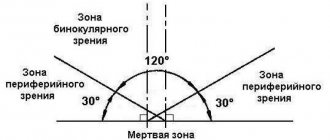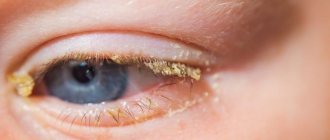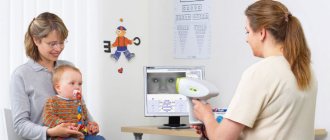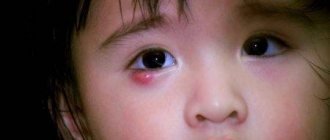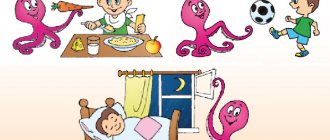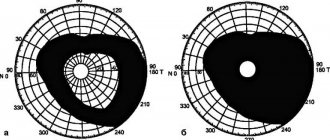Types of visual impairment
Visual impairment in a child can be functional or organic. The first are characterized by transient changes that can be corrected or can go away on their own (for example, strabismus, myopia, farsightedness, astigmatism, etc.). Organic lesions are based on morphological changes in the structure of the eye or other parts of the visual analyzer (optic nerves, pathways, etc.).
Often, with organic visual impairment, concomitant lesions of the nervous system or congenital malformations are identified - cerebral palsy, hearing impairment, mental retardation, etc.
Based on the reason that caused visual impairment, they are classified into:
- Congenital - if a damaging factor acted during the period of intrauterine development of the fetus (usually infections and metabolic disorders);
- Hereditary - when an eye disease is passed on from generation to generation (for example, color blindness, cataracts, glaucoma, etc.);
- Acquired - if the cause acted after the birth of the child (infections, injuries, etc.).
According to the degree of decrease in visual acuity, children are divided into visually impaired, with residual vision or completely blind.
Features of development of children with visual impairments
Thanks to vision, a person receives up to 90% of information about the world around him. Therefore, when this sense organ falls out, information to the child primarily comes through hearing and touch. A peculiarity of children with visual impairments is that they form slightly different ideas about the world around them than sighted people, since they form different sensory images. In raising such children, regular attention to all types of audible sounds plays an important role.
A decrease in visual acuity, in addition to limiting the child’s knowledge of the world around him, somewhat slows down the development of speech, attention and memory. Blind children may misunderstand words because they poorly relate them to the real objects that these words denote.
Physical activity plays a huge role in the development of children with visual impairments. When raising children, it is especially important to devote more time to outdoor games and entertainment, as they develop coordination and the ability to correctly navigate in space, muscle sense, teach important skills, or even stimulate vision. It is important to take into account the recommendations of an ophthalmologist and a specific diagnosis when forming options for motor activity in young children. This is necessary in order to prevent negative consequences from incorrectly selected loads.
Another characteristic of children with visual impairments is that when learning specific skills and actions, they require repeated repetition “hand in hand.” Moreover, this must be repeated until the action becomes automatic.
You need to select toys for small children with poor eyesight that are large, bright, with a textured surface (stimulates the development of the sense of touch and residual vision); they are especially interested in musical toys and those that make certain sounds.
In a family, a visually impaired child should be involved in the process of implementing family responsibilities and fulfill them as far as possible. There is no need to limit his contacts with normally sighted children.
Psychological and pedagogical characteristics of preschoolers with visual impairments in the senior group
Self-service
. Children with vision pathology have reduced control over the quality of dressing, washing, combing their hair, and reduced interest in monitoring and analyzing their actions and assessing the results of their work. The speech is poor in formulations that would represent a qualitative analysis of the work.
Musical development.
In the process of auditory perception of music and sound, certain difficulties are also observed. The mental development of preschoolers with visual impairments is closely connected with sensory knowledge of the world around them, which is full of mysteries for them. The process of forming sound images underlies auditory perception, which makes it possible to “voice” what is happening and enrich ideas about the properties of objects and life phenomena. Children with visual impairments have a significantly poorer supply of both visual and auditory concepts compared to their normally sighted peers.
Features of interaction and communication
. Children begin to understand their differences from those with normal vision. The level of self-esteem of preschoolers with visual impairments is lower and less stable; they have not formed an adequate attitude towards their defect, which makes contact with other people difficult. Impaired visual perception leads to a unique understanding of the emotional state of a partner, makes it difficult to perceive his appearance, and limits the possibilities of obtaining information about a person’s appearance. Preschoolers with vision pathology have poorer command of nonverbal means of communication; they practically do not use expressive movements, gestures, or facial expressions. Thus, speech for them serves as the most important means of communication, since they have difficulty grasping nonverbal manifestations of character, mood, and emotional state.
Safety
. Due to visual impairments, great importance is attached to the formation and development of spatial orientation skills; children learn to determine the location of objects using diagrams, from memory, and by touch.
Visual activities
. The development of hand and eye movements in children with visual impairments when performing various subject-related practical tasks has its own specific characteristics. Due to visual impairment, there is a decrease in the accuracy, speed and coordination of fine motor skills of the hands. Impaired visual acuity, tracking functions of the eye and localization of gaze leads to the fact that children do not have a clear vision of how they perform objective actions and their quality. Activities such as drawing, cutting with scissors and other similar activities are difficult for children with visual impairments. As a result, there is reduced control over the quality of work when performing objective actions, which hinders the development of visual-motor relationships: analysis, synthesis and interaction of the eye and hand.
The planned results of mastering the work program for children 5-6 years old with visual impairment
The ultimate goal of the program is to stabilize the entire course of psychophysical development of a child with visual impairment for his successful integration into the social environment.
Planned achievement results for a 5-6 year old child with visual impairments
Development of visual perception
:
· visually examines and analyzes objects according to their basic characteristics (color, shape, size);
· visually distinguishes and names groups of objects with homogeneous characteristics;
· distinguishes between geometric shapes (circle, square, oval, rectangle, triangle) and volumetric shapes (ball, cone, cube, prism);
· uses a form standard to analyze the basic shape of real objects;
· visually analyzes the shape and size of objects, selects objects by decreasing and increasing size;
· identifies and verbally denotes the size (width, length) of real objects, establishes the relationship between objects by size;
· arranges objects and images on a plane in descending (increasing) order;
· sees the arrangement of objects in the picture, names objects located further, closer;
· describes objects and finds them by description, operates not only with visually perceived objects, but also notes signs perceived by hearing, touch, smell, etc.;
· makes a whole from parts;
· depicts the simplest routes in drawings and words, makes the simplest diagrams of space; analyzes the complex shape of objects (3-5 parts) by entering sensory shape standards (circle, square, rectangle, etc.) to analyze the structure of the shape of objects.
Social and everyday orientation:
· names surrounding objects their various qualities (shape, color, taste, smell);
· navigates the variety of objects of the same type, groups objects according to characteristics by comparing pairs and groups of objects of different types;
· differentiates objects within one type;
· knows how to care for objects, toys, aids, store and use them for their intended purpose;
· knows and names many professions and their necessity;
· knows and names some tools necessary for the work of adults, electrical appliances that make human work easier;
· identifies individual actions and their sequence in labor processes;
· has an idea of some public institutions, names and understands their purpose;
· knows and follows the rules of behavior in public places;
· knows and names the name of his city, home address, the name of the street on which the kindergarten is located;
· knows and names different types of transport and their purpose;
· distinguishes between the roadway and the sidewalk; understands the meaning of traffic lights, their role for the movement of cars and pedestrians;
· knows how to assess a person’s emotional state;
· maintains correct posture while walking, at the table, etc.;
· knows and follows the rules of behavior and body care; strives for a healthy lifestyle;
· has ideas about the capabilities of his vision, uses visual orientation in accordance with visual capabilities;
· uses secure analyzers.
Development of spatial orientation:
· indicates in speech the spatial arrangement of parts of his body, actively uses spatial terms in speech;
· determines and verbally designates the spatial arrangement of toys, surrounding objects with a reference point from oneself;
· finds and places toys and objects in the named directions of the surrounding space;
· determines the sides of objects filling the space;
· moves in the named direction, maintains the direction of movement, can indicate the direction of movement in appropriate spatial terms;
· orients himself in the process of moving in space to color, light, and sound landmarks;
· understands and performs practical actions in accordance with the teacher’s verbal instructions;
· controls his actions using vision and touch;
· independently finds the way to other groups, doctor’s offices, orthoptistic nurses, typhlopedagogues, speech therapists, the head, to the music room, to the exit to the kindergarten site;
· recognizes rooms by characteristic smells and sounds, floor covering;
· navigates in microspace, knows how to place objects on a sheet of paper, on the surface of a table from left to right and in the named directions;
· arranges objects in real space according to a scheme; verbally denotes the location of objects in real space using appropriate terms.
⇐ Previous3Next ⇒
Recommended pages:
Psychophysical characteristics of children with visual impairments
In the development of a blind preschooler, three general patterns can be distinguished:
- Such a child is somewhat behind in physical and mental development compared to a sighted peer, since his activity in relation to mastering the surrounding world is lower;
- The developmental periods of a blind child do not coincide with those of a sighted child. This occurs until the other senses develop mechanisms to compensate for the lack of normal vision;
- The development of a blind child is characterized by disproportionality - some aspects of the personality develop faster (speech, thinking), while others develop more slowly (mastery of space, movements).
An important characteristic of children with visual impairments is that due to insufficient development of motor coordination, blind preschoolers are clumsy and lack confidence. Thus, with congenital blindness, the delay in the formation of walking skills can be 2-3 years. The impulsiveness of preschoolers is at the same level as that of sighted children, but due to the lack of sufficient coordination, impulsiveness manifests itself more sharply and brightly.
Only in correctional conditions do children with visual impairments gradually overcome the verbal use of words and the formalism of knowledge.
The accumulation of vocabulary and mastery of the grammatical structure of the language determines the development of coherent speech among schoolchildren of junior, middle and senior age. Children with visual impairments master coherent speech according to the same patterns as sighted children of the same age, provided that coherent speech is based on a sufficient supply of specific ideas.
Children with profound visual impairments do not have the ability to fully perceive the articulation of their interlocutor, do not have a clear image of the movement of their lips during a conversation, which is why they often make mistakes in the sound analysis of a word and its pronunciation.
The most common speech defect in blindness and low vision in preschoolers and primary schoolchildren is tongue-tiedness of various types from sigmatism (incorrect pronunciation of whistling and hissing sounds) to lambdacism (incorrect pronunciation of the sound “L”) and rotacism (incorrect pronunciation of the sound “R”),
Difficulties associated with mastering the sound composition of a word and determining the order of sounds often manifest themselves in written speech. Violations of sound sequence when writing words are largely explained by the absence or inferiority of vision. When writing, children, due to insufficient sound analysis of the word, make omissions of letters, substitutions or rearrangements.
Insufficient vocabulary, misunderstanding of the meaning and meaning of words, make children's stories informationally poor; it is difficult for them to build a consistent, logical story due to a decrease in the amount of specific information.
The oral speech of children with visual impairments is often confusing, fragmentary, and inconsistent. They do not always plan their statements. Difficulties in the development of speech in children with visual pathology include the peculiarities of the acquisition and use of non-linguistic means of communication - facial expressions, gestures, intonation, which are an integral component of oral speech. Not perceiving at all or poorly visually perceiving a large number of facial movements and gestures that give the same statements a variety of shades and meanings and not using these means in their speech, blind and visually impaired children significantly impoverish their speech, it becomes inexpressive. These children experience a decrease in the external manifestation of emotions and situational expressive movements, which affects the intonation of speech, its poverty and monotony.
Prevention of visual impairment in children
In order to maintain good vision for a long time, it is necessary to prevent vision impairment in children. This should be done from the first months of the baby’s life. Thus, a healthy child should make his first visit to an ophthalmologist together with his mother at the age of 1 month. The doctor will diagnose possible congenital problems with the organ of vision and give recommendations for the prevention of visual impairment in children. At the age of 2-3 years, visual acuity can be checked using special tables. Early diagnosis will help avoid many problems with school in the future.
Education of children with visual impairments should take into account the recommendations of the ophthalmologist. Absolutely blind children can attend specialized kindergartens and study in boarding schools for the blind and visually impaired. It is possible to obtain secondary education through home schooling. With residual vision, children with disabilities can be taught using special equipment and aids.
If a child can read, he must strictly follow the rules of reading hygiene - do not read while lying down, take breaks of about 3-5 minutes, performing special exercises for the eyes. Doctors also recommend limiting TV viewing and computer gaming time.
Video from YouTube on the topic of the article:




